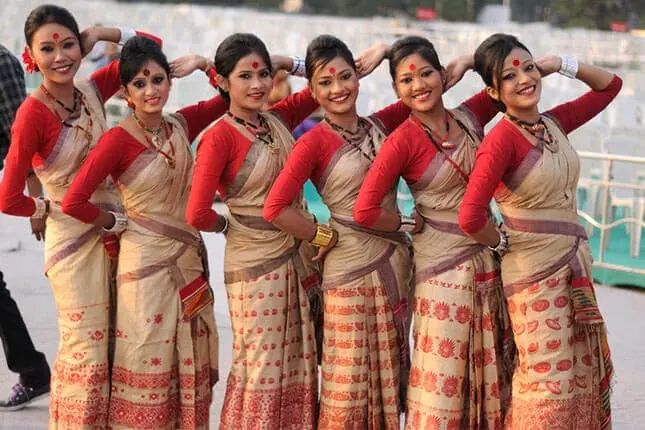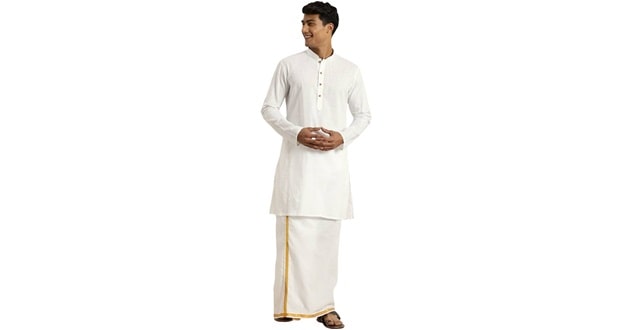At the Northeastern part of India, Assam is a state of diversity and beauty. The reflection of beauty and cultural enrichment is very much visible in Assam. The people here have a strong respect over their culture and tradition. For ages they have maintained this culture, preserved it for the next generation. Different articles of their daily lives have the reminiscence of them. The dresses of Assam also have distinct characteristics and that comes up according to these traditions and cultures. Be it the Mekhala Chador or the Gamosa, each of the dresses has a story to tell. Both for men and women, such dresses have a strong significance. How? Let us discuss on that and find out.
Assam Traditional Dress for Men:
Assam men’s attire is simple, stylish, and practical. Men’s generations-old clothing reflects the region’s culture. Main features of Assam men’s traditional dress:
1. Dhoti:
Dhotis are traditional and functional bottom garments for Assamese men. A long rectangular piece of cloth is skillfully wrapped around the waist and legs for comfort and flexibility in the humid heat. With its numerous colors and motifs, the cotton Dhoti showcases Assam’s cultural diversity. Assamese Dhotis, whether simple or colorful, demonstrate their handiwork. Wearing a Dhoti with a shirt or kurta is elegant. Beyond fashion trends, it symbolizes history and longevity. Beyond garments, dhotis signify a traditional lifestyle. It reinforces Assamese men’s cultural identity and passes down their ancestors’ traditions.
2. Kurta:
Kurtas represent elegance and culture for Assam men. Luxurious cotton or silk fabrics give it ageless appeal. Its long tunic shape and elaborate embroidery around the collar, cuffs, and front placket identify the Kurta. This luxurious embellishment showcases Assamese craftsmanship. Users may show their style and complement the occasion with kurtas of earthy to vibrant colors. The discerning man may pick a Kurta for formal or informal situations.
3. Gamocha:
Gamocha represents Assamese tradition, adaptability, and pride. This rectangular cotton fabric depicts Assam’s rich culture with intricate patterns and themes. The Gamocha’s varied applications show its versatility and cultural significance. Being used as a towel, scarf, or headgear daily makes it comfy. Gamochas beautify and symbolize celebrations. The Gamocha symbolizes respect, compassion, and peace in Assamese culture. The symbol of friendship and camaraderie builds social bonds and community spirit.
4. Jorhat Topi:
Jorhat’s famous Topi showcases Assamese heritage. With carefully made bamboo and cane conical hat, Assamese artisans skillfully weave colorful threads and jewels into the complicated design. The Jorhat Topi is revered by Assamese and worn on key holidays. It adds beauty and heritage to an ensemble, representing regional culture. Beyond its beauty, the Jorhat Topi represents Assam’s tradition and community.
Assam Traditional Dress for Women:
Traditional Assam women’s dress showcases the region’s culture, creativity, and beauty. From the Mekhela Chador to the Riha, Assam women’s clothing is timeless. Main features of Assam women’s traditional clothing:
1. Mekhela Chador:

Beautiful and traditional, the Mekhela Chador represents Assamese culture. Assamese women wear this distinctive, culturally and artistically sophisticated clothing. The Chador, a refined curtain, covers the upper chest, while the Mekhela, a flowing skirt, covers the lower body. The Mekhela Chador, primarily silk or cotton, has intricate designs, motifs, and borders that represent the region’s culture.
2. Riha:
Assamese women’s Riha symbolizes their fashion heritage. This silk or cotton blouse has intricate features and superb craftsmanship. With elaborate embroidery on the neckline, sleeves, and hem, the Riha blends art and history. From simple to ornate, its forms and patterns reflect human taste and situation. The Riha complements the Mekhela Chador ensemble with elegance and grace, creating a captivating visual symphony.
3. Assam Silk Saree:
Assamese women appreciate silk sarees, symbols of tradition and grace. This traditional item is constructed of high-grade Assam silk, recognized for its luster, hues, and craftsmanship. The Assam Silk Saree is great for special occasions due to its exquisite craftsmanship and elegance. Each saree, woven by skilled artisans using generations-old processes, has paisleys, flowers, elephants, and birds celebrating history and craftsmanship.
4. Japi:
At festivals and cultural gatherings, Assamese women wear the Japi on their heads, adding to their elegance. The bamboo and cane Japi, braided into a cone, is Assamese craftsmanship. Japis are embellished with vibrant threads and magnificent embellishments to showcase Assamese culture and tradition. Beyond beauty, the Japi represents unity, celebration, and traditional wisdom. This traditional headgear helps women connect with their roots.
Conclusion
The culture and tradition of Assam is very enriching in every way. The dresses of Assam are the bearers of that tradition and culture. Intricately woven and completed with an artistic finish, these dresses are the very emblems of perfection in its entire entirety. Surely the customs are traditions are well celebrated here in this state.

